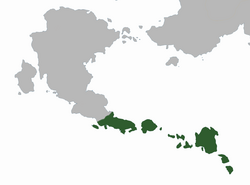Sintelia
Sintelia | |
|---|---|
| Motto: Berusaha dan melayani ("Striving and serving") | |
 Location of Sintelia in Pharago | |
| Capital | Bandar Kekuatan |
| Largest city | Bengkudu |
| Official language and national language | Sintelian |
| Regional languages | Over 250 languages |
| Ethnic groups | Over 600 ethnicities |
| Religion (2019) | 74.71% Samsara 21.01% Ihtiram 3.43% Disitru 0.36% Folk 0.49% Other |
| Demonym(s) | Sintelian Sintelese |
| Government | Federal presidential republic |
• President | Adilsyura |
• Prime Minister | Perang Wibowo |
| Legislature | Senate |
| Population | |
• 2022 estimate | 191,549,732 |
• 2018 census | 185,916,283 |
| GDP (PPP) | 2022 estimate |
• Total | $4.075 trillion |
• Per capita | $21,276 |
| GDP (nominal) | 2022 estimate |
• Total | $1.673 trillion |
• Per capita | $8,736 |
| Gini (2020) | medium |
| HDI (2021) | high |
Sintelia (/sɪn'tiːliɑ, -lja/, Sintelian: [sɪn'telia]) is a country in southeast Pharago, consisting of the Sintelian archipelago as well as the southern tip of mainland Pharago. The archipelagic nation consists of thousands of islands, though the majority of these are uninhabited, and the country's 190 million people live on only around 5% of these islands, including Berimbang, Sarudaya, Sindang and Bulu, which is the country's most populous island, home to both the planned capital Bandar Kekuatan and the largest city Bengkudu. The country is hugely ethnically and linguistically diverse, with significant minority populations of Surambanese and Asofainese people in the west and east respectively. Over 600 ethnicities and 250 languages have varying degrees of recognition throughout the country.
[ pre-18th century]
In the 18th century, merchants and traders from Hallania established initial Messenian presence in Sintelia, trading initially with Ihtiramic princes on Berimbang but later expanding their scope across the archipelago. By 1850, Hallania had established a nominal zone of influence around the archipelago. In the 1880s, following the !franco-prussian war, administration was consolidated and economic exploitation increased severely, mainly for resources and manpower. In 1940, the Bulu Rebellion significantly dented Hallanic ability to administrate the archipelago. Adopting Sintelia as a unifying identity following several decades of post-colonial philosophy and thought amongst educated natives, the rebellion eventually escalated into the Sintelian Revolution in 1941. Sintelia's independence was widely recognised by 1950, but costly insurgencies in Suramban and Asofaia as well as widespread corruption and embezzlement stifled the state's initial economic growth. Adilkata ruled the country as a strictly authoritarian party-based dictatorship from 1961 to 1987, heavily increasing military influence and kickstarting Sintelian economic growth. Today, Sintelia is viewed as an emerging power and has undergone rapid industrialisation and economic growth in recent decades.
Etymology
History
Geography
Climate
Environment and biodiversity
Politics
Governance
Law and human rights
Administrative divisions
Foreign relations
Military and law enforcement
Economy
Agriculture and fishery
Mining and forestry
Industry
Commerce and finance
Tourism
Infrastructure
Media and telecommunications
Transportation
Energy
Demographics
Largest cities or towns in Sintelia
LSN (2021 est.) | |||||||||
|---|---|---|---|---|---|---|---|---|---|
| Rank | State | Pop. | Rank | State | Pop. | ||||
 Bengkudu  Gumulong |
1 | Bengkudu | Bulu | 11,728,299 | 11 | Vaipu | Asofaia | 1,381,393 |  Kandang  Singalugu |
| 2 | Gumulong | Bulu | 3,018,762 | 12 | Kali | Sarudaya | 1,281,129 | ||
| 3 | Kandang | Sarudaya | 2,619,013 | 13 | Tamanserah | West Sindang | 1,116,987 | ||
| 4 | Singalugu | Bulu | 1,982,373 | 14 | Petangan | Bulu | 1,006,237 | ||
| 5 | Gedangan | West Sindang | 1,827,664 | 15 | Gusung | Tunggul | 912,363 | ||
| 6 | Antamotamo | Suramban | 1,693,738 | 16 | Bandar Kekuatan | Federal Capital District | 840,068 | ||
| 7 | Cipondok | Berimbang | 1,516,282 | 17 | Samusu | Asofaia | 763,391 | ||
| 8 | Jabanggelam | Kala | 1,482,772 | 18 | Sungai Sagu | North Sindang | 701,137 | ||
| 9 | Butoh Lor | Bulu | 1,411,623 | 19 | Sahatsara | Suramban | 664,494 | ||
| 10 | Lavalahitra | Suramban | 1,372,398 | 20 | Bangsri | Berimbang | 633,219 | ||


